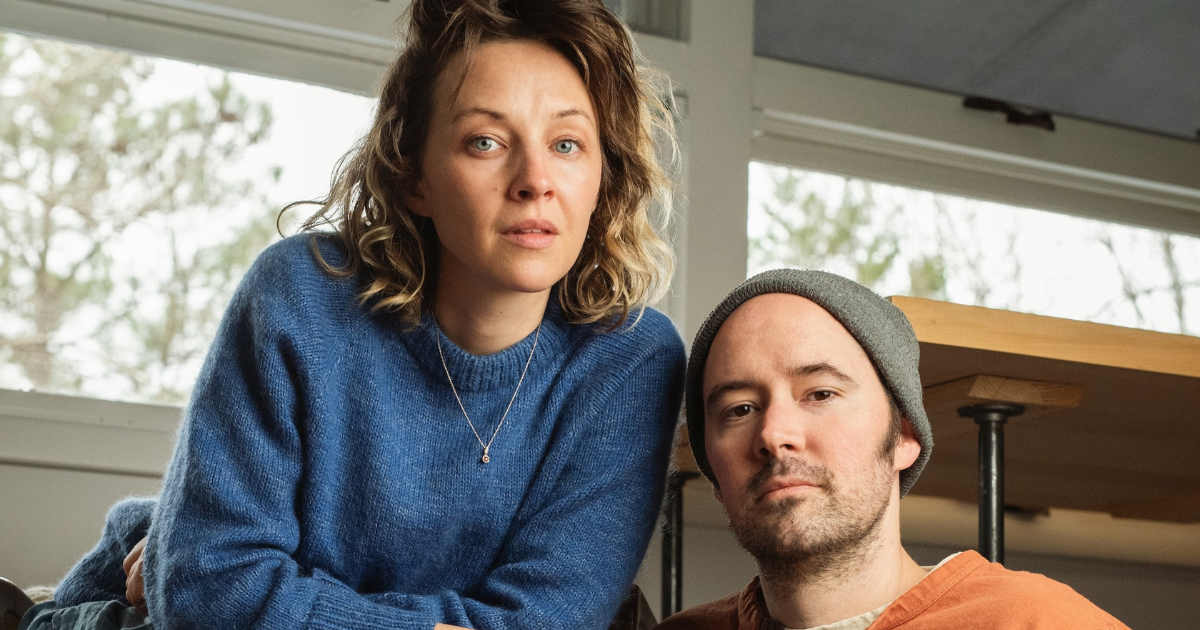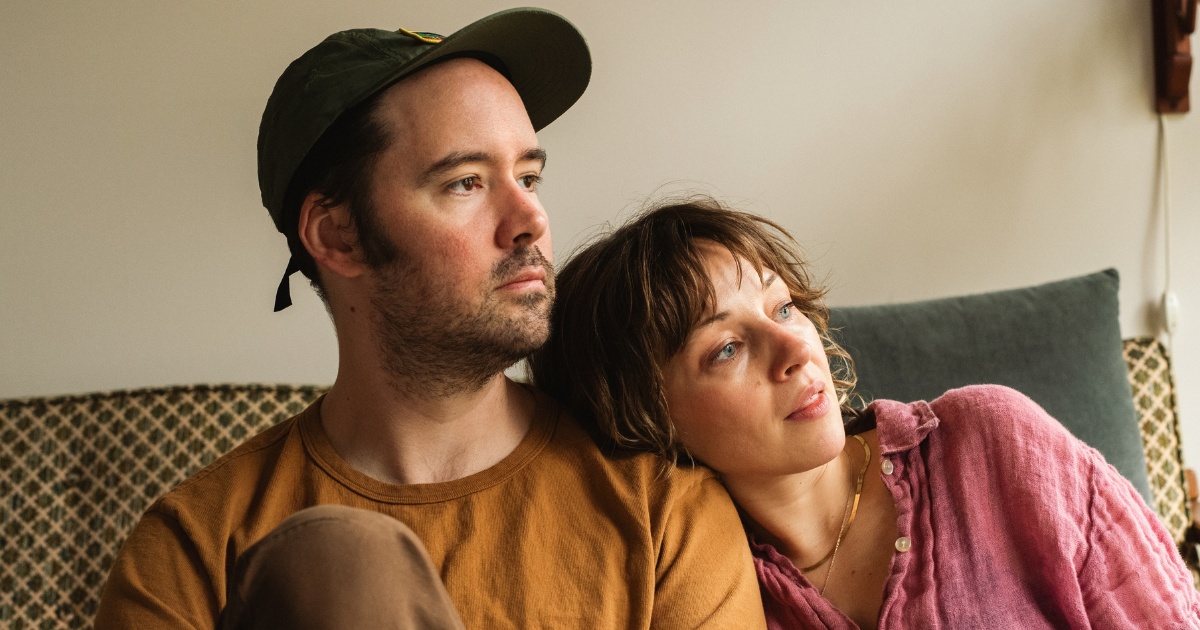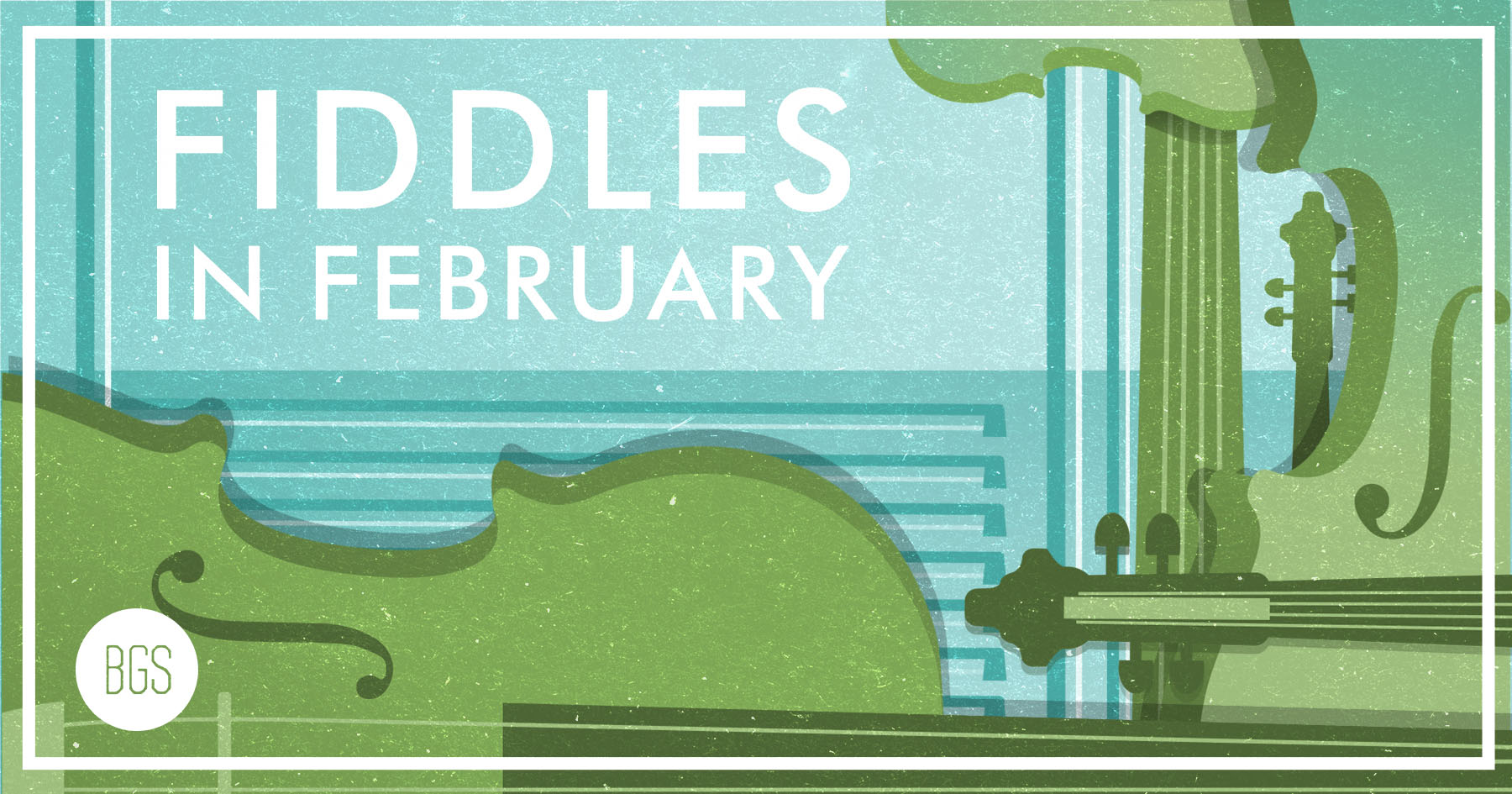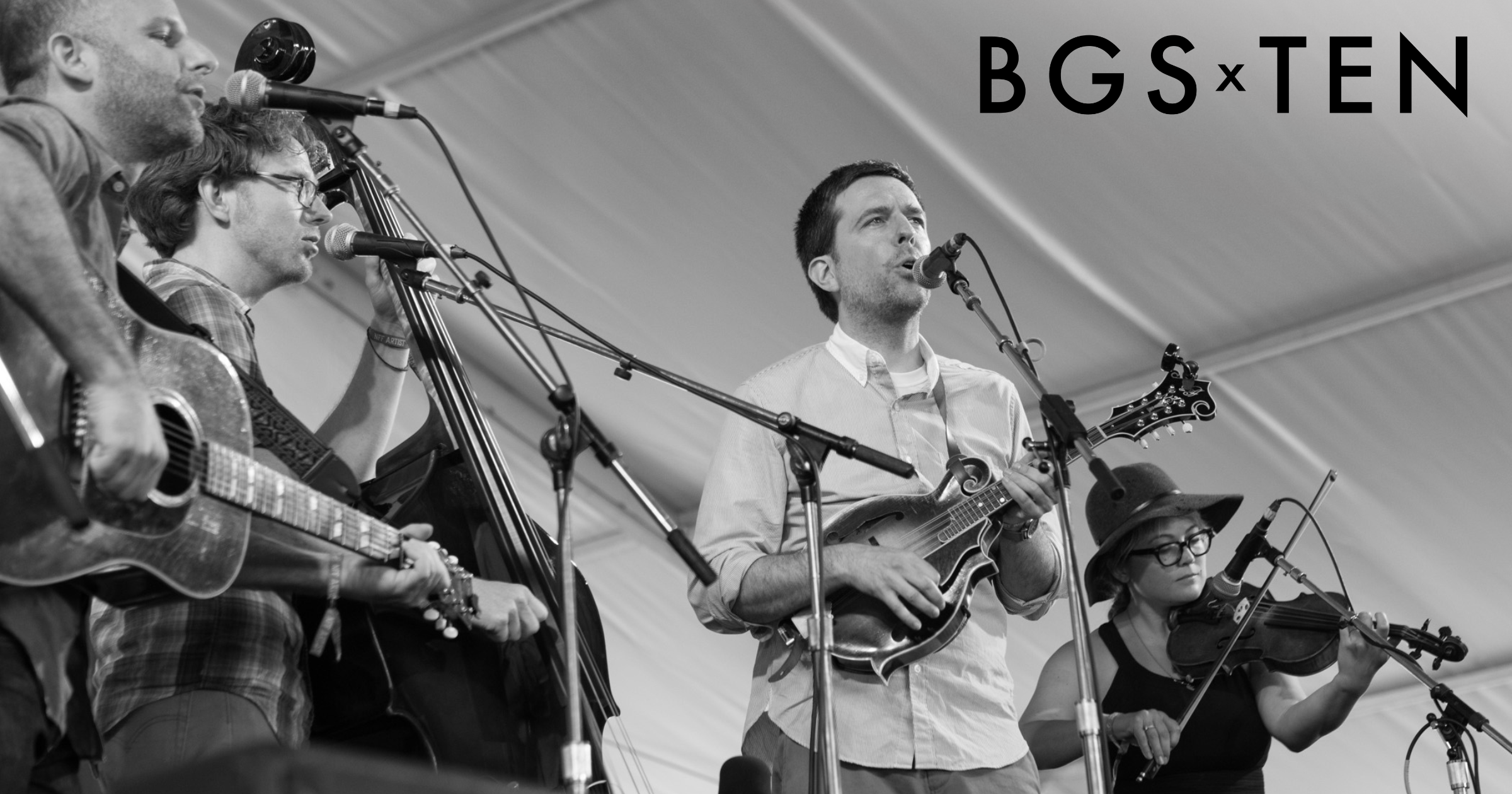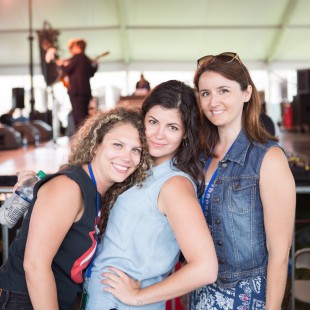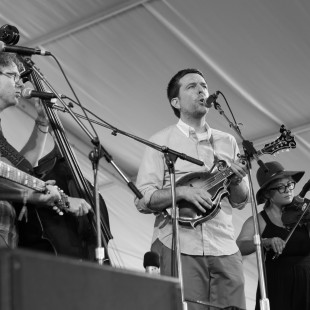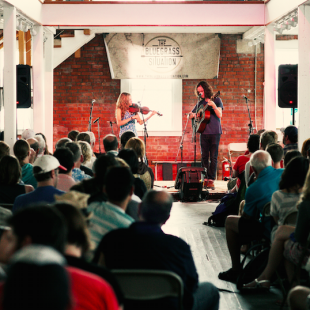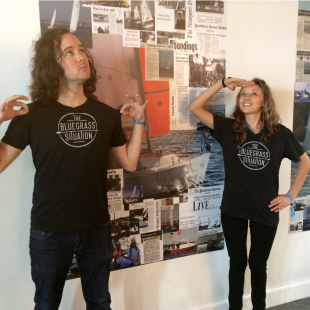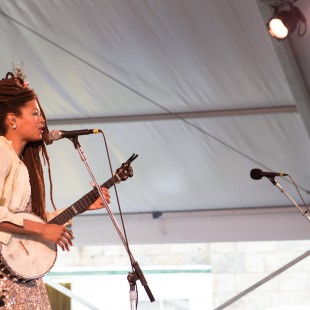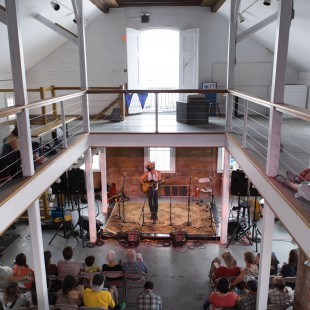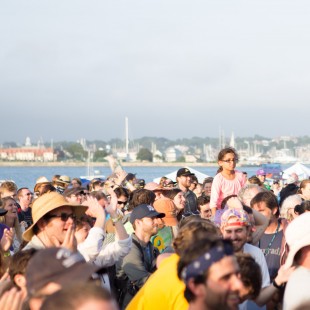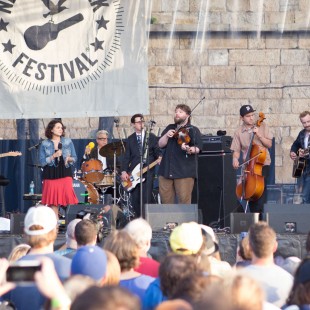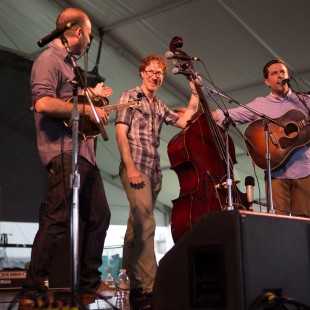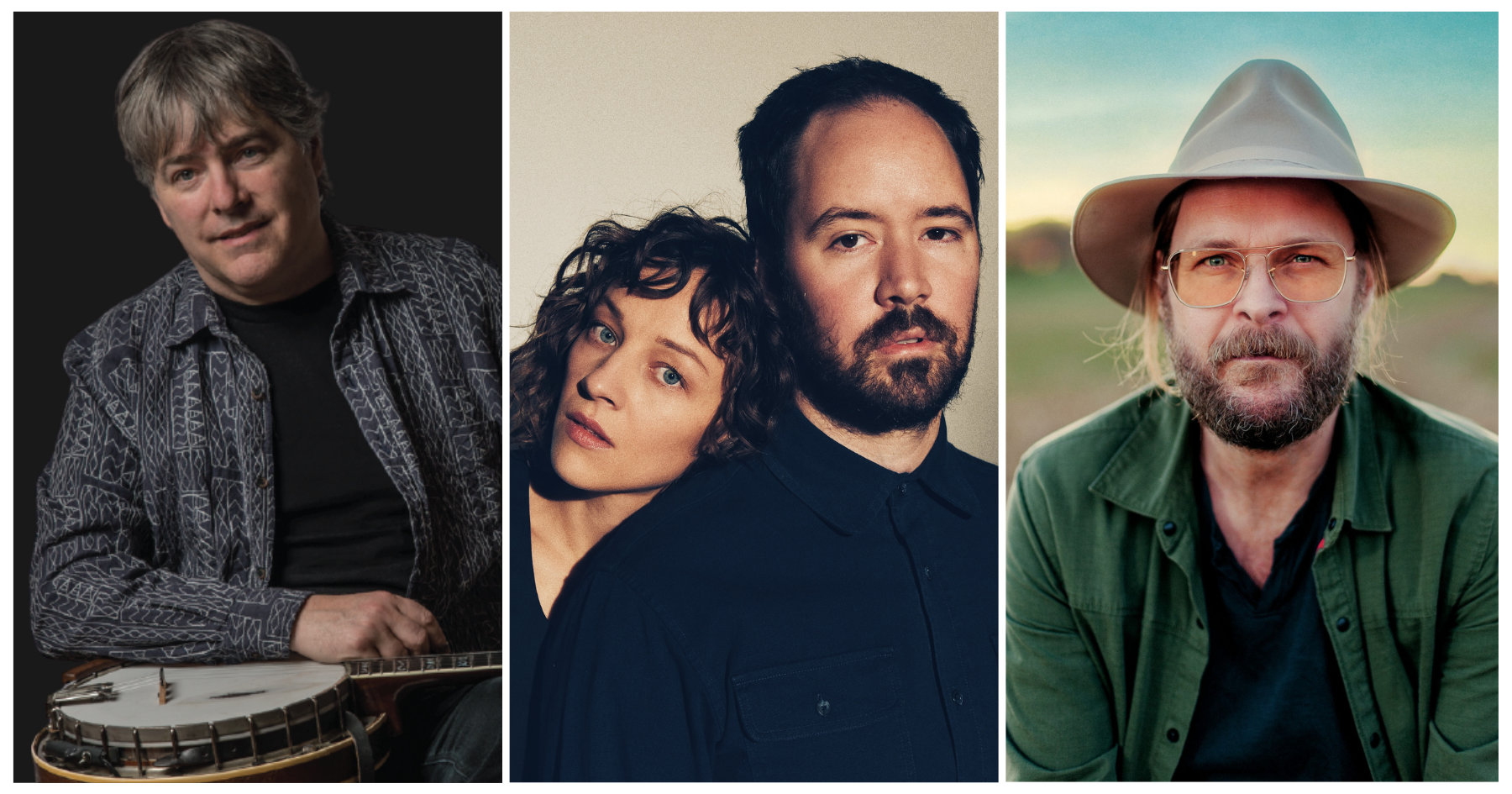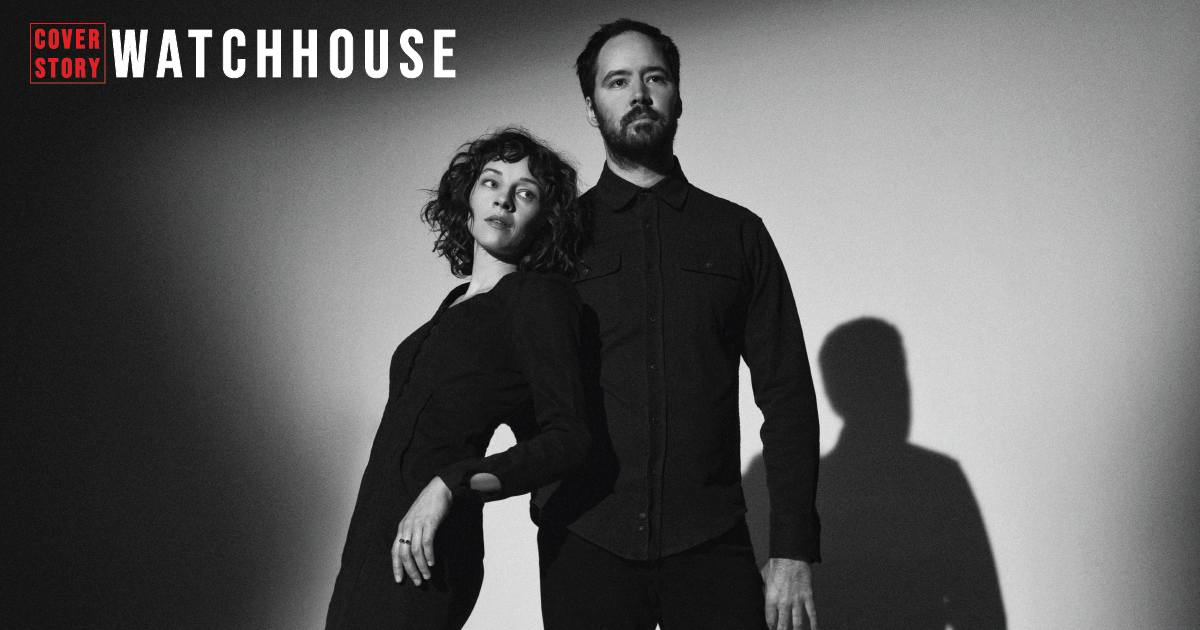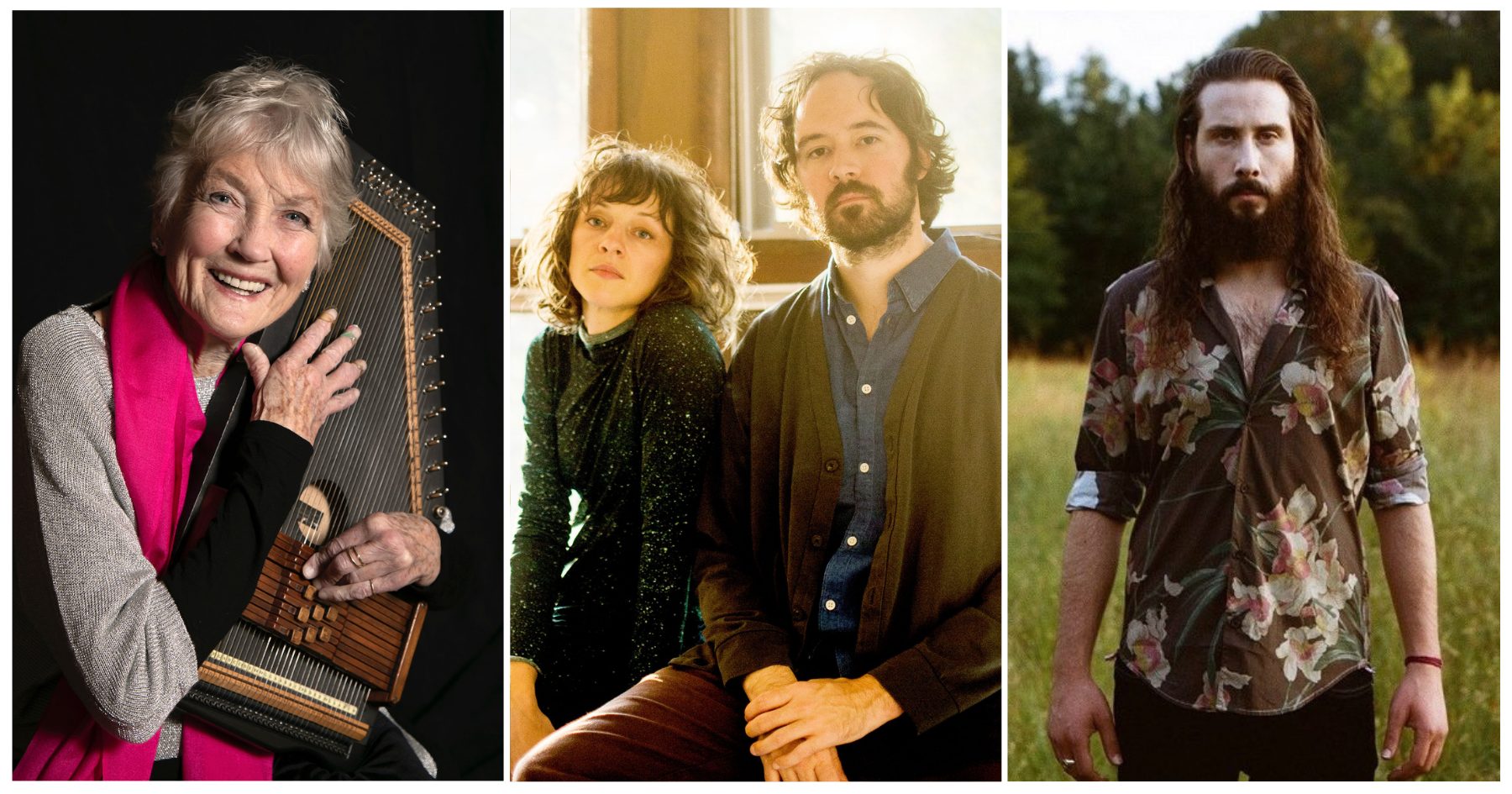Tag: Mandolin Orange
Watchhouse Found New Rituals Amid the Push and Pull of Change
Chances are you’ve cultivated a few personal routines to help you navigate the world: one for daily life, one for weekly, monthly, and so on. There’s also likely a handful of individual habits that affect how you choose to go about your routine. The former, at times, can influence the latter, fitting within each other like a pair of nesting dolls, adjacent and similar in their roles.
Then there are rituals. Though these three recurring sets of actions – routines, habits, and rituals – would seem like easily overlapping bedfellows, rituals carry an intrinsic quality the other two lack: mindfulness. Rituals bear a sense of intention like the other two, but it’s often coupled with an element of symbolism or custom. It’s not just a matter of doing something and saying it’s done; there are other connotations or expectations that may influence why doing it matters.
Holding this notion in mind, it’s Rituals that Andrew Marlin and Emily Frantz of North Carolina duo Watchhouse have decided to name their new album. Through its 11 tracks, the married musicians posit an abundance of questions and actions, their contemplations placed in settings that are as clear as a simple back porch and as abstract as a space “through the looking glass,” “beyond this to and fro.” Settings that exist outside of not only any kind of routine, but separate from time and space all together.
Though Watchhouse’s new writings don’t seem to present rituals in their conventional form, the title still feels wholly appropriate. Marlin and Frantz’s reflections, wistful pining, and open-ended ruminations don’t lead to a sense of clear, expected structure that rituals would traditionally provide, but each song is lined with an abundance of intention, mindfulness, and hope for various outcomes. Sometimes these are overtly stated – Oh, I’m dreaming of a life with you in the sun/ And I hope our time together has only just begun… – and sometimes they are dressed in metaphors: Go fire your cannonball, go and fire away/ When the ashes fall we’ll start a brand new day.
There are defined ideas that Watchhouse put forth on the album: identity and awareness, the distinction between patterns and truths, how to develop a positive relationship with change, and what it means to evolve. All the same, while our internal responses to these songs may change over time, the very act of revisiting, replaying, and reconsidering their meanings, and how we are affected by them, can be a form of ritual in its own way.
Amid an extensive tour that will take them all over the U.S. and into Canada through summer and fall, Watchhouse spoke with BGS about their collaborative dynamic, how their individual artistic instincts influence the direction of a song, and the prevalence of duality in the album – as well as in their lives.
It’s been about four years since your last album and eight years since both your lives changed from bandmates to family. Given that Rituals focuses on patterns and the perception of change on our lives, how has the ever-growing longevity of your union in marriage — and all the ways marriage transforms a relationship on its own — changed the way you perceive and interact with the music making process?
Andrew Marlin: When you hit the road and join forces with other people to play music, it’s kind of like stepping outside of the norm and stepping outside of the daily life to go up there and almost take on a role or take on a character in order to get inside the music. You kind of just forget everything that the day often requires of you, because all of a sudden those requirements aren’t there. It’s just the stage and the music and the people that are there rooting for you to go deep, you know?
I think finding that zone with Emily has had its challenges in the past, because we’re so closely tied to each other. We raise kids together and we live together, and so doing all this traveling together and playing music together too, it makes it harder – or made it harder for me at the beginning, I think – to leave the daily routine and expectations behind on stage and just shed all of that and take on that character. It’s one thing to look at your bandmates’ eyes and get a little nod or whatever’s happening during the music. It’s kind of like this understanding of, “I’m not here right now. This is just me playing music.”
Getting to that zone with Emily, now that we’re 16 years into it, has taken a while to get to that point to where it’s an acceptance of all of it, instead of just leaving things behind to get on stage. It’s like we’re carrying all of it with us at all points in time. People that come to see us get a real and honest version of ourselves, trying to go deep in the music but also being completely aware of each other too.
Emily Frantz: I was just thinking about how much things changed in 2020 and 2021, living our mundane day-to-day lives in our house, and the transition back into being on the road again and touring. We’ve obviously been doing that for a few years now since COVID, but that experience made us relearn what the relationship is between our daily life at home and touring and [figuring out] how can they coexist in a healthy way.
Ironically, the album’s opening track, “Shape,” avoids the traditional shape or structure of a song (all verses, no chorus) while the actual narrative of the song embraces ideas that lean into a sense of purgatory and a nebulous state of being — the very opposite of what would help establish a sense of shape, boundaries, identity, direction, patterns, or truths. What were the mental and emotional motivations that inspired you to take the song in this direction?
AM: It’s like establishing the shape or the pattern in order to separate yourself from it. That’s what a lot of those verses are doing, kind of outlining the things that often make me feel like I’m in a box and I’m trying to get outside of that box. The only way to do it – because there’s no real form to it – is to imagine the parameters, imagine the spaces that it ends up kind of confining you in, in order to step outside of those [boxes]. I think that was the intention with “Shape.”
EF: And the way that “Shape” came into its final form, at least final the way it appears on the record, was a lot of the things that you said about it: It didn’t ever really conform and it got rearranged and had things added and taken away from it so many times, a lot more so than other songs. But it always did feel like the backbone of this record in a lot of ways, which is why it felt really right as the opening track of this record.
AM: If there was a shape to define that song, I’d say it’s a spiral.
View this post on Instagram
How have you fit rituals into your lives and have they helped you maintain a sense of stable continuity as a family and as musicians?
AM: I feel like since having kids, the day has taken so much more form. Because I think that, and Emily [is] really brilliant about this, giving structure to the day is super helpful for them. So that they don’t have to wonder what’s happening, so that they can really pay attention to what is happening. I’ve watched both of our kids blossom in that environment. Emily’s really good about helping to create that and make sure we stick to it. Carrying that on the road has been really helpful, too and something that I didn’t realize I was going to benefit very much from. Because I definitely, when left to my own devices, am like a sheet left out to dry – just flapping in the wind. To have a little bit of structure to the day, and have to enter into these mental zones with the kiddos, has added a lot of mental structure to my existence. I think that’s the biggest thing for me.
And within that, it’s about realizing what the day actually requires of me, instead of what I imagined today to be expecting of me. Finding those real anchors and a little more gravity to the things I’m working on have helped me shed old expectations of myself and what I think I’m supposed to be doing. I think that’s what led us to be okay with changing the band name and changing up some of the sounds and approaching this thing we’ve been doing for a long time in a whole new way.
EF: I think the thing that we are [focusing on] 16 years in is finding where the balance is between freedom and artistic expression, and also just daily life and figuring out how to have those two things like coexist and make each other better and not be in a constant sort of push and pull.
The first verse in “Beyond Meaning” is intriguing. The statement of your “gentle” disposition is nice, but its seemingly conditional nature gives pause — particularly when considering that life is noisy and out of our control more often than not. What is it that you’re trying to say about your own identity and awareness of how you cope with the noise and bustle of everyday living?
AM: I feel like what I was getting at is to view it as though it’s external noise. But it’s actually internal noise. That’s often the thing that keeps me from my peace and keeps me from being gentle. It’s my own defenses and my own self-consciousness that end up creating all of this noise. It paints the external noise in a negative light. When I can control that and remember to keep my own defenses at bay and be open and actually present, the idea that maybe this external noise is not a malicious one keeps me gentle and then often what comes from that is a gentle interaction. So it’s more about controlling the internal noise in order to actually experience the external factors.
Out of the 11 songs on the album, Emily is the primary vocalist only for “Firelight.” Why was Emily the right fit to sing the story of this one song? And more broadly, what went into your shared thought process on when, and for how long, you two would sing together? Is it a purely harmony and arrangement-based decision, or do the emotions of a song influence how each vocal arrangement is structured?
EF: A lot of times it can be pretty cut and dry. If we’re deciding who should sing lead on a song, it might just have to do with the range or the key, where we think it sounds good. Sometimes that plays into it maybe even more than the lyrics or the subject matter. With Andrew doing the songwriting, he’s always been more of the primary lead vocalist. Oftentimes, by the time we’re arranging a tune and finding out how we want to present it, it’s very cemented in his voice. But then a lot of times, there will be tunes that we’re struggling with and we’re not quite finding it. By switching out who’s singing, it reframes the whole song and allows us to not just change the lead vocalist, but to find a whole different zone for the song in terms of what we hear and how it gets arranged and recorded. That was the case with “Firelight.” We had so many different versions of that song over the years leading up to recording – different time signatures, different instrumentation – and that was one of the last ones that came together for this album. Most of it got done after the initial tracking session because we were searching on it for a long time and I think I like it more and more the longer I sit with it, the more I hear it.
AM: Often people do want to know why Emily’s not singing more tunes or why the roles are what they are. But I think it’s really important to shine a little light on what Emily does behind the scenes when she’s not singing. The way she plays rhythm and plays violin or whatever instrument she’s on, it ends up being this anchor for everyone in the band. The way that offers complete structure to what we’re doing and allows everything else to sway around that a little bit, I feel like even when she’s not singing, her musical voice is such a strong presence in the music. I’ve heard her say this before, like when she’s playing violin, she’d rather not sing lead because it’s almost like having to sing with two voices. That became part of the structure of what we’ve been doing all along, not just with the lead vocal. The feel of the song and the rhythm and the chord structure and the flow of it all often is hinged on what Emily ends up doing. I think that’s just as important as her taking a lead vocal.
EF: I’ve really, over the years of us playing music together, come around to enjoying singing lead when we find the song that feels good in my range. But for the most part, I’d rather be singing harmony to Andrew and that definitely brings me just as much, if not more, fulfillment than singing lead on a song.
“Endless Highway (Pt. 1)” and “Sway / Endless Highway (Pt. 2)” leave a much heavier state of reflection than that of “Patterns,” the song you chose as the album’s finale. Were the lighter tone of the music and the lyrics a driving factor for why these last three songs are in this order? Did you want to avoid an ending that leaves the listener with a more uncertain emotional state?
AM: I’ll start off by saying Ryan Gustafson, who produced this record with us, actually ended up coming up with this track order. Having not listened to it that way and then taking Ryan’s perspective on it, it was like being able to listen to these songs in their entirety for the first time. All of a sudden, I was getting feelings from these recordings that I hadn’t gotten yet.
“Endless Highway (Pt. 1)” is a heavier song and talks about a really traumatic event that Emily and I went through and that long drone at the end of it kind of dances around the dread of that. Then into “Sway,” it’s more of a coming out of that [feeling]. How do we peek our heads out of the hole once we’ve gone down and slowly crawl back out? To finally get into “Endless Highway (Pt. 2),” where it feels like a real revelation and a real triumphant part of the record? So, you get to the top of the mountain on this song. But I do believe that while those revelations come, we get to the top of those mountains, everything’s clear, and there’s so much lightness and clarity around us, we still have to wake up the next morning, make coffee, make breakfast, get kids to school, go and run errands and carry that little mountain of revelation with us everywhere we go.
I think that the heaviness and the profoundness of that idea ends up giving way to these smaller, mundane parts of our life. That’s what “Patterns” feels like to me. It’s an admission that if we can hold on to those little revelations and the clarity they offered us, hopefully it’ll keep us light by offering us that little reminder of hope.
EF: Going back to what Andrew was just saying about having these big events or these heavy, emotional things happen, and then having to go on with our lives, and the push and pull of that – there’s frustration and beauty in it. I love the order of those [last few] tracks, because I feel both the “Endless Highways” and “Sway” are songs that were written in the middle of this album being written and there’s a lot of anguish from a lot of different sources in those songs. And then “Patterns” was the last song that was written for the album before we recorded it, so it feels like it has a certain clarity to it. Going down in the trench and making your way back up, even though it’s still really just posing a lot of the same questions [as the beginning of the album], but from a more settled state of mind.
What truths about yourselves and how you view the world have you discovered and accepted since finishing Rituals? How many of the questions you’ve posed through these songs do you feel you’ve managed to settle on answers for?
AM: I don’t think I would often look closely enough at how I was making a person feel, as much as I would look at the way the person was. I think that’s becoming more of my truth these days, just to trust that showing up open-minded with awareness and consciousness, focused on experiencing rather than projecting, is probably the closest to any truths that have come out of writing these songs and getting to the end of this record. The takeaway is that it’s not like we found answers, necessarily.
EF: It’s all just a pursuit, always.
AM: You know, it’s not always about finding answers. It’s about finding out–
AM/EF: It’s figuring out what the question is.
Photo Credit: Jillian Clark
Explore more of our Artist of the Month coverage here.
Artist of the Month: Watchhouse
What picker doesn’t dream of a bluegrass jam meet-cute? For Andrew Marlin and Emily Frantz, a fateful inauguration day jam in 2009 not only introduced each to their lifelong beloved, but also sowed the seeds for a renowned roots duo – Watchhouse.
In a radio interview with WNCW, Marlin recalls the pair’s chemistry felt immediately apparent, with Frantz’s harmonies lending new life to The Carter Family standard “Bury Me Beneath the Willow,” one of Marlin’s jamming mainstays at the time.
The North Carolina-based duo got right to work, gigging across the backyards and front porches of their Chapel Hill community. Both multi-instrumentalists and vocalists in their own right, Marlin took on the role as primary songwriter/guitarist/banjoist/mandolinist/vocalist, with Frantz augmenting via fiddle/vocals/guitar throughout their articulate arrangements.
By 2011, the pair had released two full-length albums, Quiet Little Room (2010) and Haste Make/Hard Hearted Stranger (2011) under the name Mandolin Orange. Though they would later outgrow the moniker, Mandolin Orange utilized just two instruments to primarily sculpt the duo’s sound – the mandolin and the orange fiddle. With lyrical depth and sensitive instrumental synastry, they established themselves as adept songweavers in the roots scene.
The year 2013 saw the pair signed to Yep Roc Records, a celebrated North Carolina label, starting a distinct shift in their visibility and distribution. Their debut release under the new label that year, This Side of Jordan, earned attention from an expanding national audience, with NPR deeming the record “effortless and beautiful.” They would go on to release three more albums with Yep Roc before shedding the Mandolin Orange title in 2021. Having conceived of the name Mandolin Orange in their early twenties, Marlin remarked that the shift to Watchhouse signaled leaning into intentionality, as the two had “long been burdened by the dichotomy between our band name and the music we strive to create.” As their palates developed, the sense of intimacy in Marlin’s songwriting ripened over time. Their 2019 release, Tides of a Teardrop, an album brimming with tenderness, honesty, and grief, reckoned with Marlin’s mother’s early death.
Propelled to rename the project with similar authenticity, the name Watchhouse emerged after a year of percolating during COVID quarantine. Their subsequent self-titled album, Watchhouse (2021), centered a sonic expansiveness that reached past the confines established and upheld by their moniker of old. Additionally, the duo gained full creative control as their own label, Tiptoe Tiger Music, released the record, partnering with Thirty Tigers for distribution. Layered with novel tones that veer into the vicinity of pop, Watchhouse maintains its makers’ telltale warmth and intimacy while dressing the project in a new glow.
Notably, many of these evolutions occurred in tandem with the birth and growth of Marlin and Frantz’s daughter, Ruby, who was born in late 2018. When asked by BGS back in 2021 about the influence becoming a parent has had on his songwriting, Marlin responded, “I would love to help pave a safe path for my daughter and hopefully inspire some of our listeners to be kind and open up a kind world for her to go into. And that’s made its way into my perspective even in songs where I’m not talking about it.” The songs grapple with a wide range of muses, from parenthood to life during climate change, remaining buoyant despite the weightiness of it all.
That tenor of pondering accompanies Watchhouse into the release of their 2025 album, Rituals, which entered the world on May 30 via Tiptoe Tiger Music/Thirty Tigers. The provocative 11-track collection, true to the duo’s thematic strengths, interrogates the circular nature of humanity, inspecting the relationship between steadfast, cyclical ritual and ever-evolving change.
Of the title track, Marlin states in the song’s press release, “When my circumstances change, who I think I am changes, and then my established rituals and patterns no longer serve me. This song is a leap of faith, a message to anyone feeling like they are struggling to leave a former self behind. We cement ourselves through constant sharing and projection, and it feels like it’s in direct conflict with staying present and evolving. ‘Rituals’ is a song of empathy, both for myself and for others – an acknowledgment of the celebrated nobody in us all.”
Throughout the album, Marlin’s songwriting investigates these themes, brought to life by a stunning range of vocal and instrumental performances, from harmonium to pedal steel to drum kit. Frantz and Marlin strike a vocal blend as warmly entangled as ever; listening to the two sing in harmony feels akin to being mesmerized by a crackling campfire dancing beneath the starlight. Frantz even graces listeners with a rare display of lead vocals on the track fittingly called “Firelight.”
In 2019, following the release of Tides of a Teardrop, Frantz told The Boot, “I like to play more of a supportive role, as someone who’s not doing much of the songwriting and someone who likes to sing harmony more so than lead. It’s always been what I’ve gravitated to – trying to complement the song as honestly as I can without taking too much ownership over it.”
“Firelight,” therefore, feels like a glimmering gem, a highly yearned-for showcasing of Frantz’s lilting vocals. Her timber and sway sift thoughtfully through Marlin’s lyrics of memory and connection, further infusing the album’s universe with a soft haze of timelessness.
The album art adds yet another dimension to these motifs. Its subtle depiction of domestic ritual (clotheslines, coffee machines, mugs, pots, etc.), emulates the familiar tenderness with which Watchhouse posits their profound inquiries. Reckoning with the simplicity of this imagery provokes listeners to explore the songs’ ponderings in the mundane alongside the larger overarching picture. Grown with an immense deal of care and attention, Rituals is a sonically transcendent record that begets deep inner stirrings within its listeners.
With Watchhouse presently in the midst of their album release tour, the entire BGS team is simply elated to name this dynamic pair our Artist of the Month. For all of June, we’ll be resharing articles, interviews, and music from the incredible duo from the BGS archives. Plus, don’t miss our brand new, exclusive interview with Marlin and Frantz and a special edition episode of Basic Folk featuring the duo in conversation with Jacob Sharp (of Mipso), as well. Check out our Essential Watchhouse Playlist below and, if you’re lucky, catch these wondrous performers on the road this festival season!
Photo Credit: Jillian Clark
Fiddles in February: Punch Brothers, Watchhouse, and More BGS Videos
At the Bluegrass Situation, we are fond of the fiddle! Sometimes its nuance will get overshadowed by the acoustic guitar or the banjo, but in our hearts, the fiddle always holds its own. Can it rouse a crowd of country fans in a dancehall in Texas? Yes. Can it make you weep when you hear it on an Alison Krauss record? Every time. Will we ever get tired of hearing “Orange Blossom Special”? Can’t even imagine that.
Throughout the month of February, we’re shining a light on some of our favorite fiddle content, like this excerpt from Mark O’Connor’s upcoming memoir, this Mixtape from Turnpike Troubadours’ Kyle Nix, or this interview with Becky Buller. It also seems like the right time for a (double) stop by our BGS archive. Here are five of our favorite clips along with a brand new BGS playlist at the end.
Jason Carter, “King of the Hill”
One of our newest videos finds Jason Carter and friends jamming in the Station Inn dressing room, just before an album release party at Americanafest. Joining him on this Bruce Hornsby song are Cody Kilby (guitar), Ashby Frank (mandolin), Cory Walker (banjo), and Alan Bartram (bass). Carter told BGS, “This song is for anyone who’s ever had a dead-end job or had a boss like a prison warden.”
Che Apalache, “Red Rocking Chair”
Joe Troop of Che Apalache brings an international flair to the fiddle, balancing his North Carolina upbringing with a South American history lesson. How does he bridge the gap? Find out in our BGS interview from 2018.
Watchhouse, “Hey Adam”
On their very first trip to Los Angeles in 2014, Watchhouse (then Mandolin Orange) shared a special performance of “Hey Adam.” The poignant narrative of the song, written by Andrew Marlin, is beautifully underscored by the elegant harmony and gentle fiddle of Emily Frantz. In 2019, we caught up with the duo for this BGS Cover Story.
Punch Brothers, “My Oh My / Boll Weevil”
You can count on Punch Brothers to consistently deliver something cool, even if you can never predict what they’re going to do next. Back in 2015, BGS filmed the guys outside of the Fonda Theater in Hollywood, California. A few years later, in 2018, we interviewed all five members individually for our Artist of the Month series. During our visit, fiddle player Gabe Witcher shared his childhood memories of meeting a very young Chris Thile at Follows Camp Bluegrass Festival and even playing with Bill Monroe at Strawberry Bluegrass Festival.
Sara and Sean Watkins, “You and Me”
The Bluegrass Situation emerged from the West Coast acoustic scene, so we have to give props here to California natives Sara Watkins and Sean Watkins. They’ve been friends of BGS from the beginning and we’re always delighted to follow along on their creative journeys. That includes the time we ushered them into a tiny gondola in Colorado, resulting in this wonderful 2014 live video of “You and Me.” We’re thrilled about the new Nickel Creek record coming in April, which follows Watkins Family Hour’s terrific collection (and conversation) last fall.
BGS Top 50 Moments: Newport Folk Festival
Dylan going electric in 1965. Lomax making his historic archive recordings in 1966. Joni taking the stage after 50-something years in 2022. Newport Folk is a festival full of milestone moments and lots of surprises. And for a brief moment in time in 2014, BGS was a small part of Newport Folk Fest’s long and storied history too, when we presented our Bluegrass Situation Workshop Stage inside the intimate Whaling Museum building on Sunday at the Fort.
Amidst a festival lineup that included such stalwarts as Nickel Creek, Trampled by Turtles, Dawes, Valerie June, Hozier, Jack White, and Mavis Staples, the BGS crew – helmed by co-founder Ed Helms and his Lonesome Trio bandmates Ian Riggs and Jake Tilove – hosted a few “up and coming” acts we were very excited about, singing songs about significant “firsts” in their lives. Some of those young whippersnappers you might have heard of, like Shakey Graves (joined by Chris Funk of the Decemberists and Langhorne Slim), Aoife O’Donovan, Wilie Watson (with special guest Sean Watkins), and Watchhouse (who were still going by Mandolin Orange at the time), which marked Andrew and Emily’s very first – but certainly not last – appearance at Newport.
That big “first” for us was significant – to be welcomed into the “Folk” Family and made to feel like we were all part of something big and wonderful. And it’s that feeling that’s brought us back to the Fort year after year ever since.
Photos by Samara Vise
The BGS Radio Hour – Episode 218
Welcome to the BGS Radio Hour! Since 2017, this weekly radio show and podcast has been a recap of all the great music, new and old, featured on the digital pages of BGS. This week we have a vertigo-inducing bluegrass whirlwind from our Artist of the Month Béla Fleck and an all-star lineup, we take a listen to some energetic and ethereal — yet totally traditional — bluegrass banjo from Jeremy Stephens, we dive into the latest from Watchhouse’s new release, and much more!
We’ve watched Andrew Marlin and Emily Frantz go through quite a few changes throughout their career in music, but one of the most joyful to watch has been their journey as parents. Even with COVID-19 halting touring for more than a year, their young daughter Ruby has already been to 34 U.S. states and nine different countries!
After their pandemic hiatus, the family of three is back on the road again as Watchhouse, the duo formerly known as Mandolin Orange, touring their new self-titled album. And Ruby, now a toddler, has perhaps transitioned back to road life even more smoothly than her father, who admits he’s still “struggling to find my sea legs.” For a recent Cover Story we spoke to Marlin about their name change, their new album, creativity through the pandemic, parenthood, and oh so much more.
Husband and wife duo Teddi & Bobby Cyrus are joined by Bobby’s cousin, Billy Ray Cyrus, on “Roll That Rock,” a grooving bluegrass gospel song that they wrote together. According to Billy Ray, “When I started singing ‘Roll That Rock’ my inner spirit said Bobby Cyrus will know exactly what to do with this. He did. He wrote the gospel truth and then sang the daylights out of it with Teddi and a killer bluegrass band reminiscent of Earl Scruggs and Bill Monroe.”
A new favorite of BGS, California-based bluegrass band AJ Lee & Blue Summit tell the story of the 1907 Monongah, West Virginia mining disaster in this new track.
20 years since his last bluegrass album, Béla Fleck just returned this past week with My Bluegrass Heart . Home is where the heart is, after all! All September we’re celebrating Béla as our #ArtistOfTheMonth! Hear tracks from the new project — featuring an all-star lineup — and more on our Essentials Playlist, including this song featuring Sam Bush, Stuart Duncan, Bryan Sutton, and Edgar Meyer.
In this track with an R&B groove, Mississippi’s Paul Thorn turns the contents of a YouTube video of James Brown high on PCP into a song of redemption. Yes, you read that right! As he puts it, “It’s about being optimistic with whatever time you’ve got left.”
Elder Jack Ward puts his God-given talents to work on a new album that’s full of joyful gospel and sacred soul — as evidenced on its title track, “The Way Is Already Made.”
“If you’ve got that God-given gift you can do it — your choice if you want to sing rock ‘n’ roll, blues, gospel — but I choose the right side.”
“Maybelle” is a song that sounds like it came from deep within the mountains — exactly what The Grascals were looking for. From the haunting words to the clawhammer banjo and fiddle, “Maybelle” will grab your attention.
Hiss Golden Messenger – “Sanctuary”
On a recent episode of The Show On The Road, host Z. Lupetin dials in to North Carolina to chat with Grammy-nominated songwriter MC Taylor, who for the last decade and a half has created heart-wrenchingly personal and subtly political music fronting Hiss Golden Messenger.
The Way Down Wanderers recorded “Everything’s Made Out of Sand” in one take, belting and stomping into one antique microphone. The song’s lyric, music, and sonic landscape all capture the inspiration they gathered from the temporary nature of all things.
Seth Mulder & Midnight Run recorded “Carolina Line” with an Osborne Brothers-inspired arrangement that represents many of their various musical influences.
Matthew Fowler – “Going Nowhere”
In a recent edition of 5+5, Matthew Fowler spoke on the bold authenticity of Glen Hansard, a memorable birthday show in his hometown, Orlando, putting himself in the “hot seat” of a song, and much more.
The Felice Brothers chose the very first take of “To-Do List” as the keeper, capturing the loose, playful quality of the group just getting the tune under their fingers. “The song was originally a slow waltz with the lyrics: ‘Into the fire that burns them/that’s how the idiots run,’ but I didn’t know where to go from there. I had written down a to-do list on the adjacent page and began to sing it and it seemed to work well with the phrasing. I wrote down many pages of ridiculous things and chopped them up into the melody. This is how the song came into being.”
The lyrics of Mike Younger Music’s “Killing Time” take comfort in the remembrance of past friendships forged in the fire of struggle. Younger believes that artists have nothing to lose by speaking their truth and doing so unapologetically through song. “I greatly admire those writers and creative people in general, who, through their work, have lent their voices to the struggle for equity in our society, like John Lennon, Woody Guthrie, Bob Dylan, Joni Mitchell, Nina Simone, Marvin Gaye, Bob Marley, and others.”
Banjo player and multi-instrumentalist Jeremy Stephens (co-founder of High Fidelity) has an old school, traditional approach to bluegrass that’s anything but backward. His new solo album, How I Hear It, includes several instrumentals that demonstrate this fact. “Sockeye” captures the energy and ethereal quality of Stephens’ live playing in a way many more sterile bluegrass albums, and purposefully more modern sounding records, can only aspire to.
Photos: (L to R) Béla Fleck by Alan Messer; Watchhouse by Shervin Lainez; Hiss Golden Messenger by Chris Frisina
Andrew Marlin Reveals the Observations and Explorations Behind ‘Watchhouse’
When you’re the child of musicians, you get to see the world. By the time Andrew Marlin and Emily Frantz’s daughter Ruby was one year old, she had been to 34 US states and nine different countries. “She was on a bus when she was three months old,” says Marlin. “She loves traveling.”
After a year of hiatus, the family of three is back on the road again as the duo formerly known as Mandolin Orange tour their new self-titled album, Watchhouse. And Ruby, now a toddler, has transitioned back to road life more smoothly than her father, who admits he’s still “struggling to find my sea legs.”
But then this has an unarguably big summer. Performing as Watchhouse, after more than a decade as Mandolin Orange, was no small change. A year of lockdown had given the couple space to reflect on a name change that they’d wanted for a while, but resisted, concerned at how any reinvention would affect their devoted following.
Their latest project proves that their fans have nothing to fear: a medley of richly intimate songs and beautiful vocal harmonies that’s as identifiably them as anything they’ve ever made. Marlin, who writes the songs and plays mandolin to Frantz’s acoustic guitar, spoke to BGS about the new album from their North Carolina home, where they were enjoying a short pause between gigs.
BGS: Your current tour’s taking you coast to coast, from the Newport Folk Festival in Rhode Island to Redmond, Washington and all points between…
Marlin: It’s all over the map, literally. We’re out for three or four days at a time and I’m enjoying being back on tour but it’s kind of difficult to get in the groove. After we’ve been moving at a snail’s pace at home this past year, this all feels so fast-paced, so much to keep up with!
How do you feel about touring in this age of COVID. Does it feel safe yet?
I was one of the naive ones who thought we were nearly done with this thing, but we’re really not. There is a vaccine but people just aren’t taking it. So no, I don’t feel safe at all. But it’s a balancing act: we need to make money because we haven’t worked in 18 months, and we want to play shows, because that’s what we’re driven to do. Everybody wants to get back to their lives, everybody needs purpose to stay sane. To feel like there’s a reason to get up in the morning.
Was a year of lockdown hard as a new parent?
It’s all relative. Emily and I travel so much that we wouldn’t have spent so much time home as full-time parents otherwise. Eighteen months ago you would have been talking to a different person, but now I just try to live day to day, and write a little here and there. It was really difficult to write at the beginning of the pandemic, though. As a songwriter I try to latch onto things that not many people are writing about and with so many people thinking about the same thing it was hard to separate myself from it and find a way to write about it that didn’t seem unoriginal. I wrote a lot of instrumentals so I could explore how I was feeling without having to put it in words.
Have you discovered some good tunes for getting Ruby to sleep?
Pretty much anything by Paul Brady. She loves him, especially that album he did with Andy Irvine. I put that on and she’ll start talking to Paul and Andy. And because she’s been around our music since she was in the womb, if I sit down and play mandolin very quietly that’ll chill her out. I’ll sit in her room and play and she’ll doze off.
There are a lot of songs sung from a parent’s viewpoint on this new album: “Upside Down,” “New Star,” and “Lonely Love Affair.” Has becoming a father changed your perspective as a songwriter?
Passively, yes. I think the change is that I would love to help pave a safe path for my daughter and hopefully inspire some of our listeners to be kind and open up a kind world for her to go into. And that’s made my its way into my perspective even in songs where I’m not talking about it.
That’s very much the message of “Better Way,” which is about online trolling. Was that inspired by a specific incident?
A number of incidents. It isn’t unique. Every time somebody puts themselves out there on social media you have the people who love to drum up negative energy. And I can’t wrap my head around it because that’s not how I was brought up. I rarely meet people who would do that when they’re talking to you face to face. So I don’t understand why those people feel compelled to sit at their computer or pick up their phone and try to rip others apart. It’s a weird way to live.
Emily says it’s one of the favorite tracks you’ve ever laid down together.
Yeah, I love the sound of that tune. It’s a gentle drive to it, the way the groove is so set. It has this steady pulse that fits with the whole idea of the tune, this nagging thing in the back of my head: why do people feel compelled to be such assholes?
These songs were recorded all the way back in February 2020. Where did you decide to record them?
We did it right outside of Roanoke, Virginia. It’s not quite in the mountains, but it was in the hills for sure, a very peaceful place on a lake. I like making records in places that aren’t studios. It feels a little more free, to just go sit in a living room and to turn that space into a very positive musical environment is way more appealing to me than a studio where you’re watching the clock and every time you hear it tick that signifies a certain amount of money. I think you feel that relaxed energy. There’s no trying to beat the clock on this record. It’s exploring all the directions we could go as a band.
The sound of the album is certainly more exploratory than previous ones — a little richer in texture, a little less acoustic, even a touch psychedelic at times…
There are a lot of sounds we’ve used in the past but on this one we didn’t try to hide them. In the past we’ve tried to keep the simplicity of what Emily and I do in the forefront and have all these light textures around that. I think of it as a mountain peak. We’d be up at the top singing our songs and beneath us is this luscious forest, a lot of organ songs, electric guitar, drums, bass. Well, on this record we brought all the sounds up to the same level.
We’d been touring with many of these musicians since 2016 and so we were already thinking about arrangements that worked for the band and it’s a good representation of what we can do live, as a unit. A lot of people think of Emily and I as a folk duo but we have a lot of music in us! It felt nice to change the name and feel we can do whatever we want to and not limit ourselves to any idea of who people think we are.
The new name, Watchhouse, seems to be a good choice to reflect the observational world of your songwriting.
One of the most important things you can do as an artist is observe the world around you and I’ve always sought out those little peaceful places I can let my mind wander. I don’t do well in chaotic situations. I’m not the one to be right up the front by the stage in a show. I’ll usually go hang out in a corner and close my eyes and listen. I just like to find those places wherever we are, whether we’re on tour, in our neighborhood, or at home.
It makes you sound like a pretty chilled person to live with.
I play music a lot, so if you don’t like to hear constant music then probably not… in lockdown there was a lot of noodling, a lot of searching. A lot of aggression being taken out on an instrument too.
Fair point, I can see Emily needing an occasional break from that.
Oh yeah, all the time! She’d send me out of the room, or she’d go out herself…
You’ve been in a band together for 12 years, and all that time you’ve been a couple too. How do you manage to spend so much time together without driving each other crazy?
We’ve talked about that sometimes, especially with Emily’s parents. They can’t seem to wrap their head around it. I guess we just like each other!
One song on the album that seems especially raw is “Belly of the Beast.” Can you tell me the inspiration behind that?
I wrote that tune after Jeff Austin committed suicide. I didn’t know him super well, but we had a lot of mutual friends and had crossed paths through the years and it woke me up in a scary way. Being a full-time musician you have to continually find new ways to stay relevant and interesting to people, and you have to deal with real bouts of anxiety and self-consciousness. Is this good enough? Am I good enough? Writing and playing is something I’m extremely driven to do for myself, but I also have to do it for others, and I throw my music out in the world to be judged by other people. It’s a weird process that I’ve found is extremely helped by therapy!
So is that what performing is for you: “Hiding from the monsters in the belly of the beast”?
Yes — I love that line. When people talk about being nervous to perform, for me it’s not wondering whether I’m able to perform well, it’s more that when I step out on stage I don’t know what that crowd’s energy is going to be, how receptive they’re going to be. Are these people going to allow me to be myself tonight or am I going to have to put on a hat? For the most part our fans are really receptive and I can be myself. That’s when it feels like things are right.
“Beautiful Flowers” is one of the more cryptic songs on the album. It starts with a tiny flash of color and ends with some powerful images about the climate crisis. How did you get from one to the other?
I hit a butterfly when I was driving down the road and it really bummed me out. Animals have no ideas what cars are. For something to come out of nowhere at 70 miles per hour has got to be the weirdest thing in the world. And that got me thinking about who had made the first car, and it turned out it was this guy, Karl Benz. And when he made this car he had no idea where it was going to lead and how terrible it was going to be for the environment.
For our own convenience we destroy a lot of this world and don’t give a lot back as humans. And my car hitting that butterfly felt like a really strong metaphor for what we’re doing to the earth. It’s a very delicate ecosystem and we’re killing all its intricate little working parts.
Is that a challenge for you, too, with your own carbon footprint as a touring musician?
Our carbon footprint is massive, riding on buses and planes and cars… going to a festival and them using generators to supply all the power. We all see all the problems but how to step outside of your own daily needs and confront them is the conundrum, and I’m as guilty as anyone. How do you inconvenience yourself to make positive change in this world? We’re asking ourselves that right now in terms of racism, climate change, housing inequality, you name it.
Given how personal the songs are, and the fact they’re drawn from your shared life, do you ask for Emily’s input or approval as you’re writing them?
No, not really. The way I write I’ll take a specific idea and continue to break it apart until it’s more universal. I don’t want to reveal too much of myself in any given tune. I’m not laying out a bullet point retelling of my life, just musing on how I felt in a given situation — or maybe how Emily felt, or maybe a friend of ours. In fact sometimes I’ll play a new song for Emily and I’ll tell her what it’s about and she’ll say, “Huh, I thought it was about this.” And you know what? She’s not wrong.
Watchhouse is coming to the Theatre at the Ace Hotel in Los Angeles on Saturday, February 19th 2022 – grab your tickets here.
Photo credit: Shervin Lainez
The BGS Radio Hour – Episode 206
Welcome to the BGS Radio Hour! Since 2017, this weekly radio show and podcast has been a recap of all the great music, new and old, featured on the digital pages of BGS. This week, we bring you new music from jam-grass band Leftover Salmon, the debut single from Watchhouse (formerly known as Mandolin Orange,) and so much more! Remember to check back every week for a new episode of the BGS Radio Hour.
Leftover Salmon – “Boogie Grass Band”
Leftover Salmon has been playing what you could call “boogie grass” for over 30 years now. After their COVID-induced live music hiatus, the founding Colorado jam-grass band brings us a new album Brand New Good Old Days, and this next song celebrates that boogie grass sound that everyone loves.
Avi Kaplan brings us a song about finding gratitude and beauty in every realm of life, good or bad. His hope for the listener is that they can “find gratitude in their life regardless of what end of the spectrum they are currently in.”
As our Artist of the Month for April Peggy Seeger put it herself, “Folk is full of raunchy songs, but they’re not often sung.” In our recent interview, and on her recent album First Farewell, Seeger ruminates on the joys and sorrows of aging.
Sam Armstrong-Zickefoose wrote this song about feeling you’re on the outside looking in. Sometimes even after moving towards the direction of “fitting in,” it’s still easy to feel out of place.
John R. Miller is a true West Virginia picker-singer-songwriter if there ever was one. While inspired by folks like John Prine and Steve Earle, Miller is celebrated among the same stature — including by his friend from the same region, Tyler Childers. We mark John R. Miller’s 2021 signing with Rounder Records with “Faustina,” a single that brings promise of a great debut record.
From Bristol, UK, Lady Nade wrote “Willing” to foster acceptance, loyalty, and friendship. The video was filmed in her hometown along the route of a Black Lives Matter protest last summer. As she explains, “the way the video and song came together portray the message of self, as well as community.”
For fiddler John Mailander, “Returning” captures the collective feeling amongst the musicians in the studio playing together at the time of recording, the rediscovery of connection and joy after so many months of isolation.
After more than ten years as the duo Mandolin Orange, burdened by the dichotomy between the name and the music they strived to create, Andrew Marlin and Emily Frantz changed their name to Watchhouse, deciding through the COVID-19 pandemic that the time for change was now, given the growing and soon-to-be opportunities for bands to share their music on a live stage again. Here’s their first single since the change!
With his new album, Room for Everyone, Alex Heflin intends to highlight that inclusivity in both genre and personality always adds interest and excitement to a medium. In this case, the track “Guest Room” benefits from that approach.
Zach Schmidt spoke with BGS in a recent edition of 5+5 on the influence of Guy Clark – and greasy enchiladas! – on facing loss and working through it, spending time with Mother Earth, and more.
Mark Rubin, Jew of Oklahoma (feat. Danny Barnes) – “My Resting Place”
Mark Rubin wrote this old-time bluegrass number inspired by the drive of Jimmy Martin, yet based on a 100-year-old Yiddish poem. He says, “If I’m being honest, I wrote it with Del McCoury in mind as the thought of a 100-year-old Yiddish labor ballad sung on bluegrass stages cheers me to no end.”
Richie Furay – “Go and Say Goodbye (Live)”
Rock and roll legend Richie Furay’s new collection 50th Anniversary Return to the Troubadour celebrates his long career with bands like Poco and Buffalo Springfield — and his connection with former bandmate Stephen Stills’ music remains as strong as ever. Furay has recorded this song, written by Stills, with every band he’s been a part of over a half-century career.
“They Say You Loved a Good Man” was written about former president Calvin Coolidge and his wife Grace, but ultimately, it’s a song about regret — living your life with the best intentions, yet still falling short of expectations.
Abby Hollander Band – “Still Got It Bad”
Abby Hollander recently joined BGS for a 5+5 — that is, five questions and five songs — and brought us this tender bluegrass heartbreak tune.
Photos: (L to R) Peggy Seeger by Vicki Sharp; Watchhouse by Kendall Bailey; Avi Kaplan by Bree Marie Fish
Mandolin Orange Changes Its Name, Unveils New Video as Watchhouse
The duo Mandolin Orange have surprised fans with a new video and a name change to Watchhouse. Band members Andrew Marlin and Emily Frantz shared on social media, explaining how their former band name didn’t necessarily encapsulate their personal songs.
They wrote, in part, “This past year has been the first time we’ve stayed still since we were 21, and the pause gave us the opportunity to sit with ourselves and set intentions. We have long been burdened by the dichotomy between our band name and the music we strive to create — if you’ve heard the songs, you know they are personal. Now that we can see a future where music is a shared experience again, we’re defining the space we share with you on a stage or in your headphones, and making it one that welcomes our creativity and anyone who wants to listen.”
FRIENDS! Our band is now called Watchhouse 💖. Same music, same us. We’ll tell you more about it: pic.twitter.com/0Klwh0WtBS
— Watchhouse (formerly Mandolin Orange) (@watchhouseband) April 21, 2021
The band’s most recent project has been 2019’s Tides of a Teardrop, although Marlin released two instrumental albums earlier this year. To coincide with the announcement revealing Watchhouse, the band released a new video for the song, “Better Way,” produced by Josh Kaufman and released via Tiptoe Tiger Music / Thirty Tigers. Take a look:
Photo credit: Kendall Bailey
We’re Looking Back (and Forward ) With Mandolin Orange’s Music at the Mansion
At the one-year mark of the pandemic drastically changing our daily lives, let’s take a minute to reflect. Sure, we’ve seen more livestreamed content than we ever cared to see, we’ve ordered more takeout than we deem reasonable, and we’ve had far fewer haircuts than we’d like to admit in the last 12 months. Live music has all but disappeared from our lives. Although the brilliant artists we love have found creative ways to connect with their audiences, fans haven’t been able to regularly engage in a person-to-person musical experience in some time. As we reflect on all these things that have come to pass, it is this author’s earnest and sincere hope that we also look forward.
The live music experience is gradually coming back, too, and to remind us of the beauty of an intimate acoustic performance, we’ve dug up this video from Mandolin Orange’s show for the North Carolina Department of Natural and Cultural Resources. Now that spring is here, let the joys of new beginnings fill your home by watching this full set and remembering what it’s like to crowd into a room to hear beautiful music, seeing no mask and fearing no illness. As tumultuous as the last year was, let us remember, celebrate, and continue pressing on, making preparations for the possibility of having intimate musical experiences like this once again in 2021. Watch the lovely concert below.
Photo credit: Kendall Bailey

